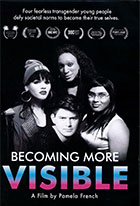
Becoming More Visible 2016
Distributed by The Video Project, 145 - 9th St., Suite 102, San Francisco, CA 94103; 800-475-2638
Produced by Pamela French
Directed by Pamela French
DVD , color, 73 min.
High School - General Adult
Adolescents, Transgenderism
Date Entered: 08/17/2017
Reviewed by Sophie M. Forrester, Reed Library, State University of New York at FredoniaBecoming More Visible follows four young transgender people in and around New York City, all at different points in their transitions. Morgin, a Latina woman, has fully socially and physically transitioned; Sean, a white man, has socially transitioned but only recently begun hormone therapy; and Olivia, an African American woman, and Katherine, a first-generation Bangladeshi American, live as women part-time. Although the inclusion of nonbinary people would have been a great addition to the film, its ethnic diversity is more than welcome, when most coverage of trans people is confined to white and Black people.
That setup is also the film’s greatest weakness; since the four subjects aren’t connected, the film can seem disjointed as it hops from one to another, particularly at the beginning. However, the four subjects together offer diversity not only of ethnicity but of experience. Morgin and Olivia have both fled unaccepting families, and Katherine is struggling with hers, while Sean is largely embraced by his parents. Likewise, Sean, Morgin, and Olivia all hope to be entertainers (a comedian, singer, and model, respectively), whereas Katherine aspires to be a social worker.
The film also handles Olivia’s bipolar disorder and Morgin’s mood swings lovingly, portraying them neither as scary or hysterical, nor as par for the course for trans people. The varying backgrounds within one film serve as an antidote to many profiles of transgender people that lean too heavily on tropes of disempowered dreamers with big personalities.
Although Becoming More Visible is occasionally frustrating, with its time skips and slight lack of focus, it is an interesting look into the lives of four young trans people, and evidence that trans people are just as diverse in their personalities as cisgender people. It is recommended for public or academic libraries, especially those trying to bolster their LGBT+ film collections.
Awards:
- Award of Merit, Impact Docs Awards, 2016